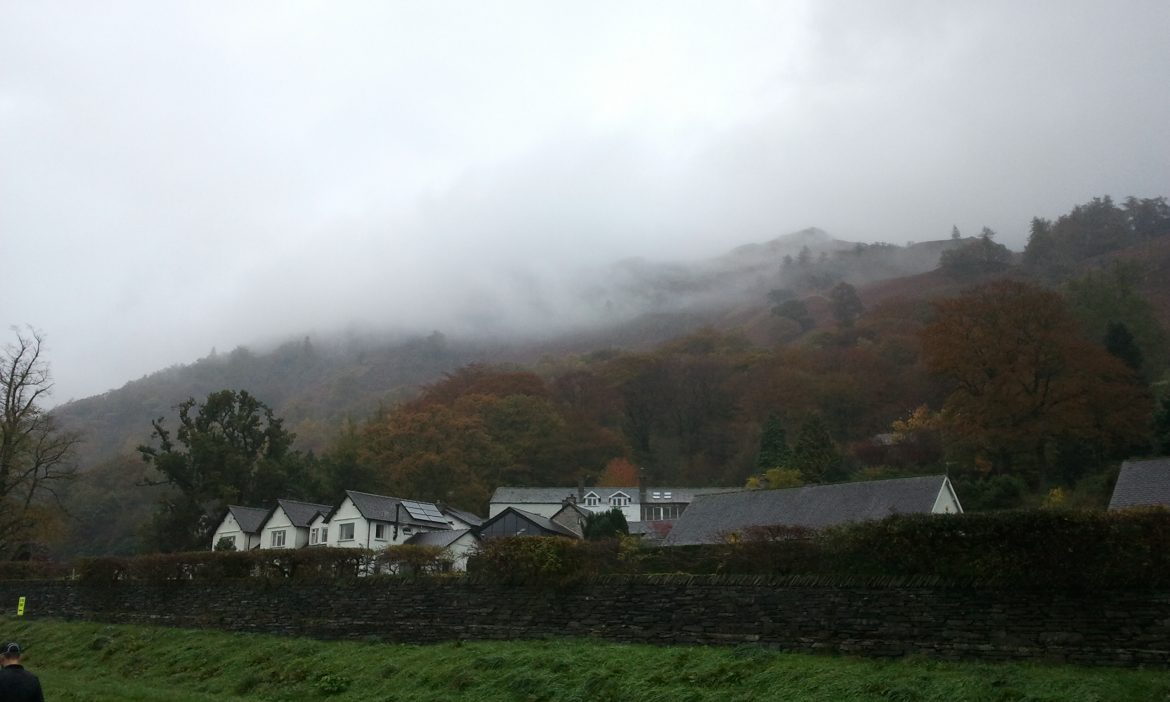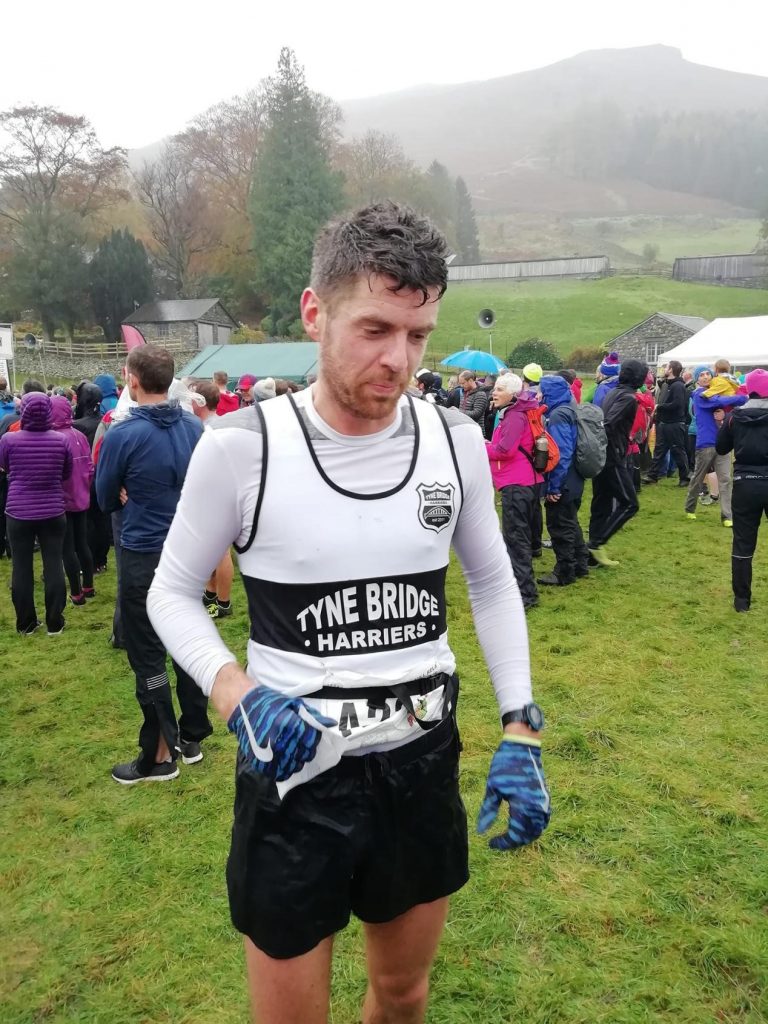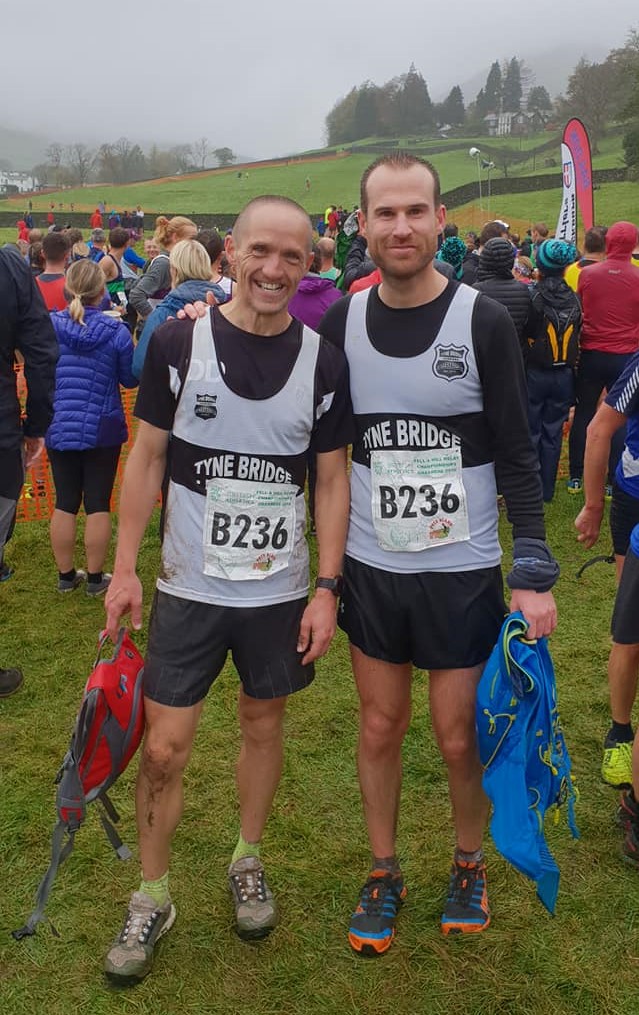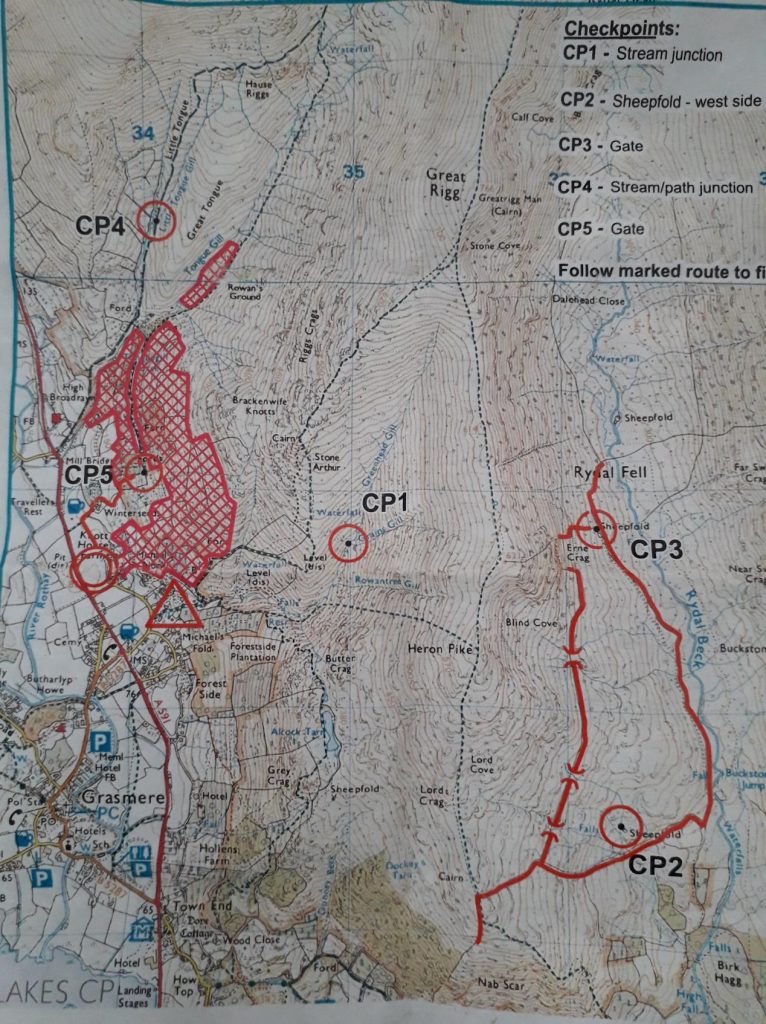British Fell and Hill Relay Championships
Grasmere, Lake District
Saturday, 20th October 2018
Report by Vicki Deritis
with contributions from Marc Fenwick, DD, Cees van der Land and Alex Black
Tyne Bridge Harriers has sent teams to various races around the country but had never sent a team to the British Fell and Hill Relay Championships which, this year, took place in Grasmere in the Lake District hosted by Ambleside AC on the 20th October. I was always going to go over to Grasmere for the event as John (Tollitt) was running for Northumberland Fell Runners but thought that it would be another feather in the club’s cap if there was representation from Tyne Bridge Harriers at one of the year’s big events in the fell running calendar. Whilst we have quite a few members who are interested in and enjoy fell and trail running, the distances involved in the race legs together with the amount of ascent, the rough terrain, potential for adverse weather and navigational issues meant that this event was likely to be at or, at least, towards the edge of most people’s comfort zones.
Our team, which was entered into the Men’s Open category, comprised of:-
Leg 1- Marc Fenwick (solo leg, 5 miles and 2400’ of ascent),
Leg 2- DD and John Hurse (paired leg, 6.7 miles and 2800’ of ascent),
Leg 3 -Cees Van Der Land and Tom Charlton (paired navigation leg)
Leg 4 -Alex Black (solo leg, 4.3 miles and 2000’ of ascent)
We were one of 250 teams entered in the event. This included ones from leading fell clubs such as Keswick, Helm Hill, Bingley and Carnethy as well as teams from the North East such as North Shields Poly, Elvet Striders, Tynedale, Northumberland Fell Runners and Durham Fell Runners. Our enthusiasm was high but familiarity with the Lake District fells and fell running in general was a little bit lower. Fell shoes were hastily purchased and some of the mandatory kit to be carried (waterproof full body cover, hat, gloves, compass, whistle and emergency food) was loaned.
The Lake District forecast for race day had been for cloud mostly above 2000’ and mainly dry. That would have been nice. Instead, what it actually was was cloud above about 750’ and that enduring wetness which the Scots call driech. Everyone’s numbers, dibbers, maps and food and drink tokens were handed out and we headed up to the event field with it’s massive marquee, which was to be the base for all of the teams, their supporters and lots of dogs, ready for the off. Here’s what happened……..
Leg 1 – Marc Fenwick
After a quick course briefing from team leader and kit supplier VD I was ready to go. Fresh with the knowledge of knowing that my leg had two check points then it was all downhill, all I had to do was make it to the top and the rest would be easy, I couldn’t have been more wrong. After a very conservative start, due to the lack of fell running experience, I gradually got into my stride and started to pick people off. After around 3 miles of continuous climbing, I finally found myself at the second checkpoint, in a group of about 5 runners, somewhere in the clouds.
As we started to descend I quickly realised I was way out of my depth! My legs were going faster and faster and I couldn’t slow myself down, panic set in and I decided to do a tactical army roll / bum slide to stop myself from going off the side of the cliff. After this, my confidence was shot. From this point on it was literally about survival. Unfortunately, my lack of experience descending cost me around 20 places. However a top 50 finish was still on the cards so I regrouped and hung on for the final 500m stretch and was glad when it was finally over.
Leg 2 – DD
Leg two of the race was referred to as the ‘Queen stage’, which in sporting parlance means ‘The stage of a multi-day road race which is deemed the hardest, most demanding and most prestigious stage of the race’. I think they were underselling it.
Following a terrific run from Marc in Leg 1, myself and stage partner John (Hurse) soon hit the first ascent of Leg 2. Twenty minutes later we were still climbing the first hill of Leg 2. It would take another 40 minutes before we would reach the summit, an ascent of 3 miles. But if I thought our troubles were over, I was sadly mistaken.
With the top of the hill shrouded in a fine mist, the descent back down to the finish area was treacherous. Trail shoes offered no grip at all on the slippery rocks and footpaths and I would have been better off wearing a pair of banana skins on my feet.
Despite a few hairy moments, we successfully managed to reach the foot of the mountain (by that I mean, without breaking any bones!) and all that stood between us and the finish line was argh!!!
With less than 400m to go, I slipped on a grassy bank and proceeded to slide on my backside for a good 30 metres down a sodden muddy field. At least it provided entertainment for the watching marshals and spectators. Not to mention one hell of a challenge for Surf come laundry day.
Finishing hand-in-hand, we completed our leg and passed on the challenge to Cees and Tom.
Leg 3 – Cees Van Der Land
The longest leg, therefore the longest report?
Relay events are great as it is one of times that the very individual sport of running becomes a team effort. And, for the case of the 3rd Leg of the British Fell Relays, it was even better as we would run this as a pair and had to do some navigation! After a pick up by John Hurse from Haydon Bridge and a smooth ride, accompanied by DD banter to the Lakes, we drove into the Rothay Valley to Grasmere for the start. The Rothay valley was carved out by a glacier, leaving a wide U-shaped valley and (potentially) magnificent views, however, that wasn’t the case today as the clouds were very low, obscuring any recognisable peaks. Tom and I picked up our bibs and dibber from Vicki (accompanied by John T. from NFR ![]() ). We wouldn’t get a map of our leg until after we started our leg. We watched Marc start and, after he set off, we then went into the normal “relay state of mind” of not knowing exactly when to get ready for the start. We trotted about a little, ran up the first half mile of (what we thought was) the route and got ourselves into the starting pen. Then we waited for the Leg 2 runners to come back. We waited, waited a little bit more and then waited a little bit more, trying to spot the runners coming in down the hill. After seeing at least 6 look-a-likes we were finally, really sure we saw two TBH vests coming down, yes!
). We wouldn’t get a map of our leg until after we started our leg. We watched Marc start and, after he set off, we then went into the normal “relay state of mind” of not knowing exactly when to get ready for the start. We trotted about a little, ran up the first half mile of (what we thought was) the route and got ourselves into the starting pen. Then we waited for the Leg 2 runners to come back. We waited, waited a little bit more and then waited a little bit more, trying to spot the runners coming in down the hill. After seeing at least 6 look-a-likes we were finally, really sure we saw two TBH vests coming down, yes!
For a navigation run you get handed out an ordnance survey map at the start which show the locations of all the checkpoints you will need to visit in a particular order. This map often contains “no crossable lines” and areas that are “out of bounds”, furthermore, as this was a paired run, you would have to stay within spitting distance of your running partner. My running partner was Tom Charlton, the one from the 5k club record, so that would be a challenge. I wished the course designers would be friendly to my slower running legs by making a large portion of the route not runnable so I would be able to keep up with Tom. That wish definitely came true!
After a tag by DD and John Hurse we were off! Steep up a little track and we got our map handed to us. We continued running up while trying to make sense of the map. Questions of “where is actually the start?” and “what is the scale?” were shouted at each other. As we had plenty of runners ahead of us the solution was to keep following them for now until we hit CP1. We kept going up the left hand side of a river stream and, in the distance, we could see runners turning around going up on the other side of the valley. Based on the map they must have already been to CP1 which was confirmed shortly after by our first dib of the day!
We kept pushing the pace on this section that was still runnable and overtook a long conga line up the narrow sheep track away from CP1. By this point we were a bit more convinced of our route and realised we had to veer to the south first before heading east to circumvent Heron Pike on our way to CP2. However, after following other runners, we came across a big lake which for some reason, I couldn’t find on the map (it is quite obvious). A quick compass reading did convince me to turn left here and keep following runners up the hill into the clouds. This quickly became too steep and boggy to run, even for Tom. While hiking up we took a better look at the map and now realised actually where we were. Most runners kept going up onto Lord Crag while we veered to the south, avoiding the top and hoping to find a stream that would take us down to CP2. The downhill wasn’t too boggy or steep and quite runnable and we managed to overtake a few more people here. And we found CP2 after 26 minutes. Looking at the split times, this section is where the leaders in the race at that moment (Keswick) got lost and took over 45 minutes. Given that the clouds would have been lower (it cleared during the day) and that, unlike us, they had no one to follow I can completely understand that now!
From CP2 to CP3 we decided to take a slightly longer route to find the start of a track instead of crossing fells. We moved quite quickly on the track and could see some runners up the hillside struggling, good choice! CP3 was quickly found and we were faced with a massive hill that rose over 300m in 1200m, an average gradient of 25%!
Looking at the map, the shortest line between CP3 and CP4 just looks impossible. Sane people running in hills go approximately parallel to the steepest slope and the highest point of their run is usually the col between the peaks, not the actually peak. For the relays this meant that most leg routes were shaped like an elongated oval in a N-S direction, running near parallel to the valleys and ridges. The route between CP3 and CP4 was directly from east to west, going over 2 ridges a right angle. Going up from CP3 this involved imitating a fell sheep, we were on all fours. Near the top I made the mistake of looking back/down. This made me slow down significantly. I was very happy I bought new fell shoes the week before, this would not have been possible without them. Tom was getting ahead of me quite a bit, even on this insanely steep bit we were still overtaking people. Once we reached the crest we followed the path north towards the col before Great Rigg. It was nice to run again. The downhill towards Tongue Gill was steep. This is where it was most obvious who the more experienced fell runners were as they still kept on running while we were quite often down to carefully stepping down. We did make it into the valley in one piece and we could see the final hill of Great Tongue ahead of us. We tried running up through the high heather but, at this time, most of the energy had disappeared from my legs. A great crossing over the top and navigation resulted in us hitting CP4 spot on (we saw lots of runners having to do and out and back along the valley).
The route of the final descent to the finish was quite obvious and we could actually run again. The familiar feeling in your legs to be able to run again after a long steep boggy section is one of my favourite things of fell running. We were running quite happily until the leg 4 runners joined the course and we got overtaken (left in the mud really!) on the downhill by a girl. As consolation, we had been running about an hour longer than her? A final bid and we tagged Alex to set him off on his leg.
900 metres of climbing and descending in 11.4 km means an average gradient of 15.7% for the hills. To quote my running partner “That was… something, but it has nothing to do with distance running”. A great day out in the fells with likeminded people, what more can you want! Thanks Vicki for organising the team, including lots of emails in the last week from the organiser about route changes and the weather. And thanks Tom for waiting for me at the end of that loooong steep climb and not training as much the last few weeks so I could pretend I could sort of keep up.
Leg 4- Alex Black
The ‘glory leg’, and on Saturday, supposedly the easier leg – well my legs disagree!
Leg 4 started with a 2000ft climb over 2miles, which was spent mostly on my hands and knees wishing for a break in the relentless slope. Before long, an orderly queue formed as there seemed only one sensible path up, and the quicker people got caught up behind us slower ones.
At the top of the first ascent, and above the clouds was the first check point, where the poor marshals gathered in a small huddle keeping each other company. If the other runners where anything like me, conversation was impossible and the marshal’s job would have been very lonely.
Checkpoints 2 and 3 were pretty uneventful. The route took you along a well trodden ridge, with clearly marked little flags. I was a little surprised when I found another runner coming straight at me, but soon realised a flag or two must have blown away and we headed on putting our trust in the muddy tracks.
The village and event marquee was somewhere below as we reached checkpoint 4, well hidden by the low cloud coverage. Here the route got interesting. Anyone with any sense would have probably took some time to pick the best route down, but John had advised that the racing line was a straight descent down – top to bottom in near enough 1mile. 2000ft drop in 1mile.
I started throwing myself down the hill, only to be overtaken by some other, presumably more experience fell runner, using the seat of his pants to catapult him through the field. So I followed, gracefully avoiding the hidden rocks and stone walls, and returning to my feet every so often to build up some more momentum.
Fell running is a slight exaggeration. I walked, grappled and slid my way around the route. It goes to show you don’t need experience or athletic ability to take part, just a reckless disregard for self-preservation and strong desire to get back to the car first.
We set out wanting to enjoy the day and have everyone back safely without any mishaps or injuries. We did that and, as a bonus, finished a credible 98th out of the 245 teams that started that day. I hope that we are able to make our attendance at this Championship a regular occurrence and, in the future, enter more than the one team as I know that there are other club members who would like the opportunity to take part in this exciting albeit slightly scary event.
Vicki
Splits
Leg 1: 54:43 (48th on leg)
Leg 2: 1:48:13 (231st on leg)
Leg 3: 1:42:20 (70th on leg)
Leg 4: 49:45 (70th on leg)
TBH Men finished 98th overall.
Full results can be found here.









2 comments
Well done everybody on what was a tough, if enjoyable, day on the hills.
Fantastic effort and achievement Gents not forgetting our team Manager Vicki on yet another chapter in the TBH story,In Marcs words out of his depth i think id be out of my depth in a puddle of water